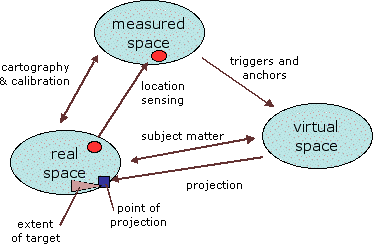- scenarios
- train
- twin doors
relating the real and the virtual – 3 types of space
Although we usually think of relating physical space and virtual space in augmented reality, there are in fact three types of space to consider:
- real space - actual objects in actual physical space
- measured space - the representation of that space in the computer and the representation of locations of objects from sensor data etc.
- virtual space - electronic spaces created to be portrayed to users, but not tied explicitly to the real world
Note that virtual spaces may themselves be models of real world things (e.g. virtual tourism, architect's walkthrough), but this differs in intent from a similar representation used to track locations of real objects. ... more later

These three types of space are related in different ways.
real - measured
- mapping - the representation if the real space will involve some cartographic process of measuring points and their relations, either against a global system (e.g. GPS) or relative to one another (e.g. theodolite or simple tape measure)
- location sensing -
measured - virtual
- triggers - events (collisions, entering active anchor areas, proximity) may trigger actions in the virtual world. Note that as these are triggering electronic world events they will normally (always) be triggered from representations of the objects and space in the measured specs rather than directly by the physical space (arguably something like triggering by physical contact could be a counterexample).
- identity - the same measurements of a real space may be used to construct a virtual space (e.g. architects plans -> VR walkthrough)
virtual - real
- subject matter - the virtual space may in some way represent or be about a particular real space. For example, a web page about London, or a virtual model of the Eiffel Tower.
- projection - the virtual world must be made manifest at some particular point in the real world. This has two aspects:
- point of projection - the device that embodies the projection is in the space (on a screen, in VR goggles)
- extent of target - where the projection appears to be in physical space. For example, in augmented reality we may see something projected via stereo vision within the real world. Also, in a video wall, the space being projected would appear to be 'the other side' of the screen - that is occupying actual space (albeit through a wall!)
Note that the very last example would also be true of the video wall was projecting a web-cam picture - that is projection can also be a property of measured - real space relationships. So, first cut may not be perfect!